MENUMENU
Fish of Ngwe Saung
Fish of Ngwe Saung
The reef is home to fish of both of ends of the spectrum- from small bait fish through to the largest varieties of sharks on earth. There are several main factors that signify each major group, including (but not limited to) their size, color, shape and behavior. Thus, the major families of fish species that can be found near Ngwe Saung.
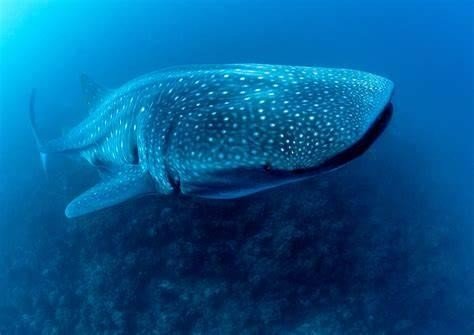
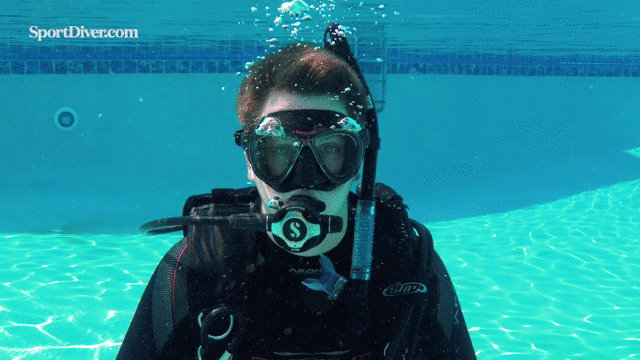
Whale Sharks ဝေလငါးမန်းများ
The whale shark (Rhincodon typus) is a slow-moving, filter-feeding carpet shark and the largest known extant fish species. The largest confirmed individual had a length of 18.8 m (61.7 ft). The whale shark holds many records for size in the animal kingdom, most notably being by far the largest living nonmammalian vertebrate. The whale shark is found in open waters of the tropical oceans and is rarely found in water below 21°C (70°F). Studies looking at vertebral growth bands and the growth rates of free-swimming sharks have estimated whale shark lifespans at 80–130 years. Whale sharks have very large mouths and are filter feeders, which is a feeding mode that occurs in only two other sharks, the megamouth shark and the basking shark. The name "whale shark" refers to the fish's size, being as large as some species of whales, and also to its being a filter feeder like baleen whales.

Butterfly Fish (ငါးလိပ်ပြာ)
A close relative of the Angelfish, Butterfly Fish share many physical characteristics but are typically distinguished from Angelfish due to their more elongated, thinner “noses” which tend to jut out from their main body. Similarly vibrantly coloured and patterned (with the dominant colour usually a bright yellow), they add colour to what is already a vivid tapestry of rainbow-coloured marine creatures.The bodies of Butterfly Fish are very thin, which help them navigate through smaller passages so that they can dine on their usual diet of coral polyps or algae growing on the reef. Butterfly Fish are also known for being incredibly loyal to their mates, and stay with them for life.
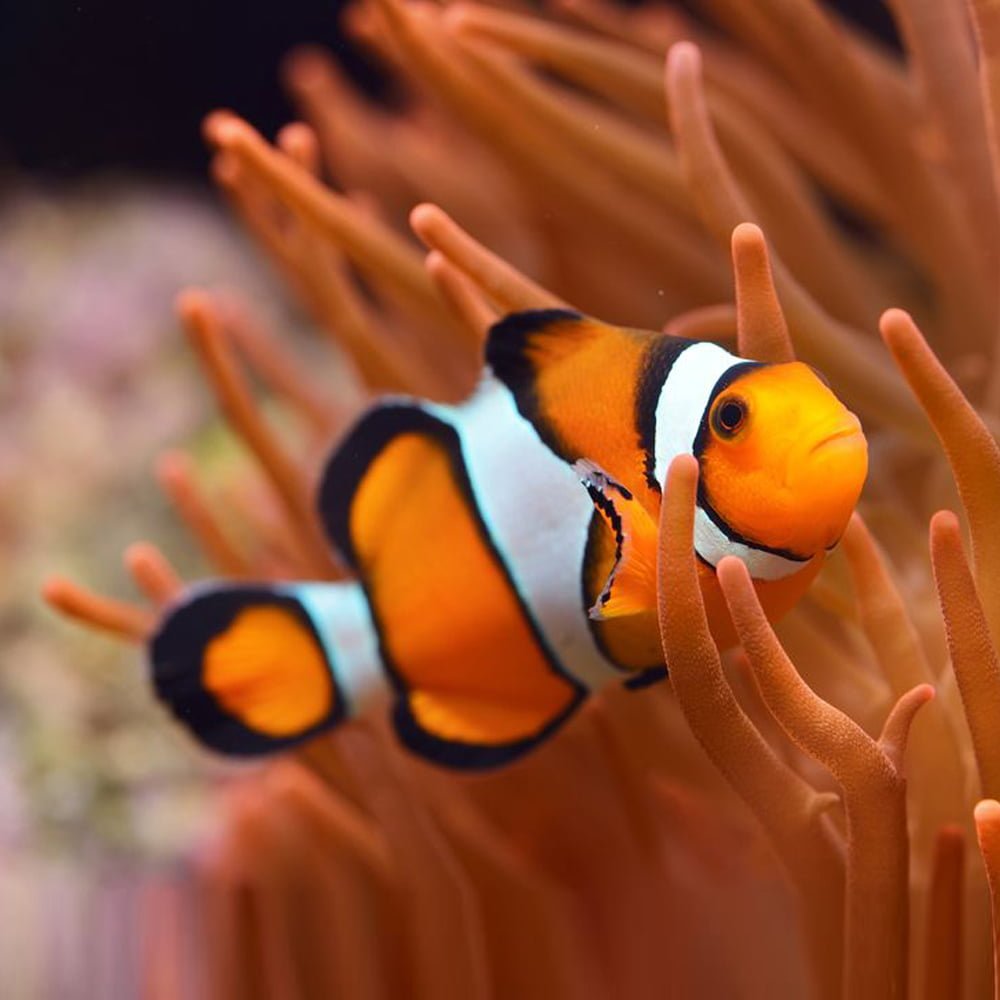
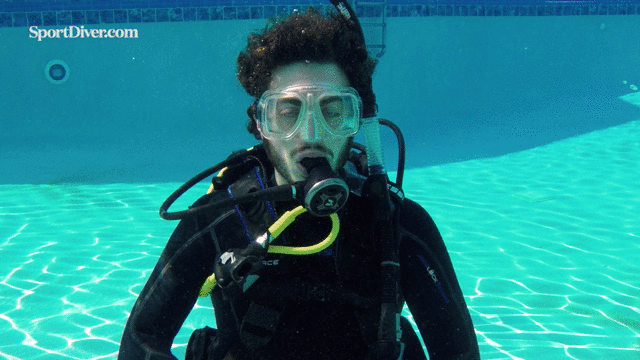
Clown Fish နီမိုငါး
Also known as Anemone fish, Clown Fish have recently sprung to international fame due to Disney/Pixar’s hit CGI movie Finding Nemo. Anemone fish are extremely popular with the diving community, and Clown Fish in particular are characterised by their highly recognisable markings, typically with a bright orange colouring coupled with a glowing white or light blue band. Their habitats are the sea anemones from which they derive their name, having built up an immunity to the otherwise poisonous tentacles of these soft ocean plants via coating themselves in a layer of mucous. This acts as a natural defence system against passing predators, as the Clown Fish can nestle itself amongst the anemones which will poison any overaggressive threats to the fish – a truly symbiotic relationship. While they are small in size, Clownfish are also popular for being one of the most accessible species of fish in the Ngwe Saung due to their tendency to inhabit shallower waters, making them often visible by snorkelers without needing to dive down further into the reef’s depths.
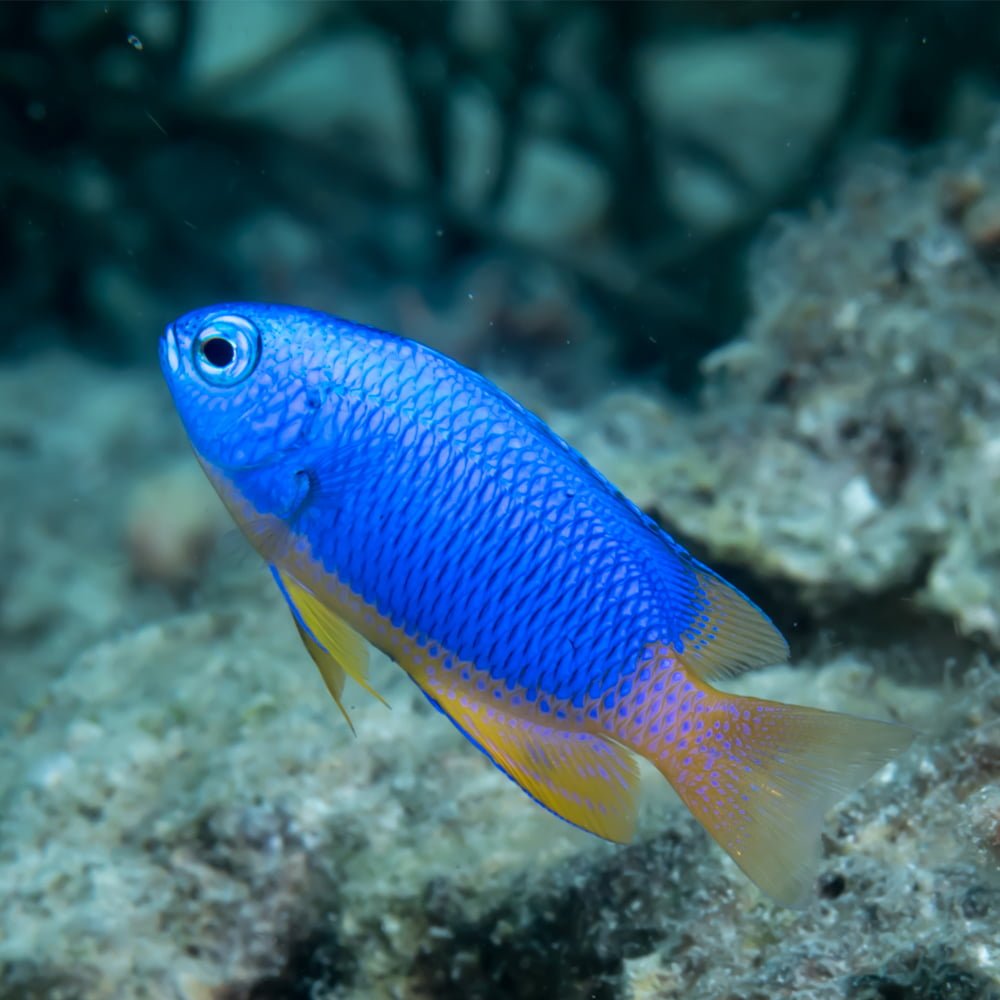
Damsels အပျိုစင်ငါး
From stunning bright colours to drab, muted hues, Damselfish are one of the most common species found in Ngwe Saung and can be seen virtually everywhere. Damselfish are surprisingly territorial for their size and diverse coloration. They typically stake out a designated “home” amongst the coral reef which they will then defend with their lives often against predators much larger than themselves. Depending on subspecies their diet consists of either plankton or algae, with the plankton eaters typically having brighter colours and the algae feeders being duller shades of orange and brown.
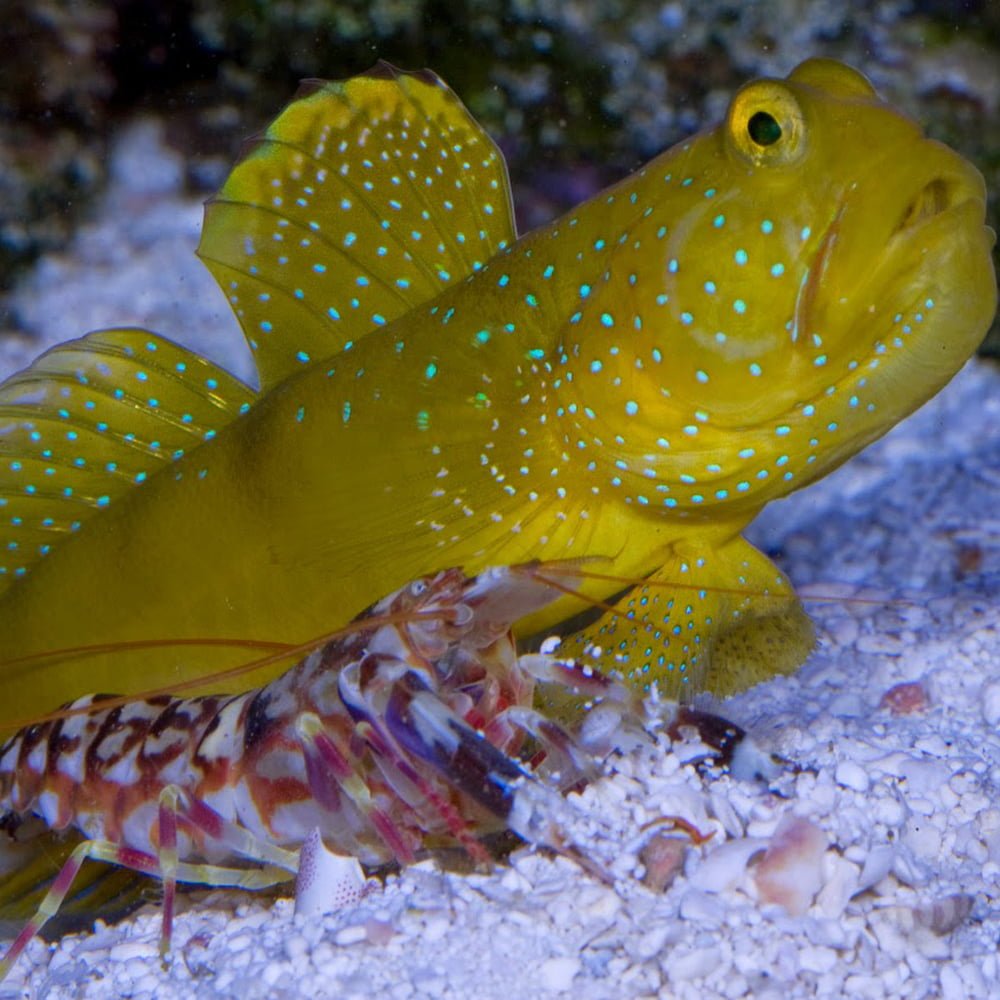
Bottom Dwellers
Gobies ငါးပုတ်သင်
Gobies are a huge family of fish that are tiny in size and with short lifespans. Unfortunately for the Gobies, they perform a sympathetic yet essential function within the ecosystem of the Ngwe Saung as they act as prey for a large number of predators within the same habitat. Gobies mainly reside at the bottom levels of the reef and typically travel either alone or in small groups so as to avoid detection from predators.
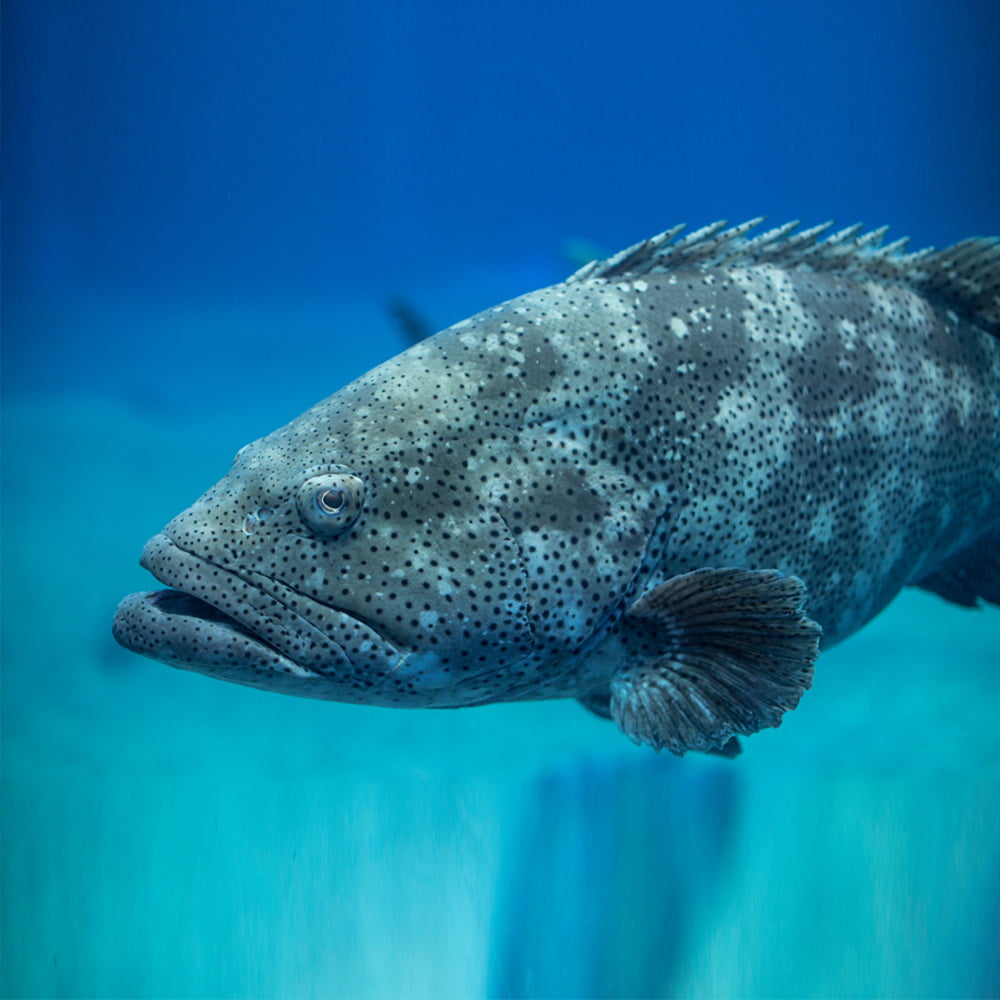
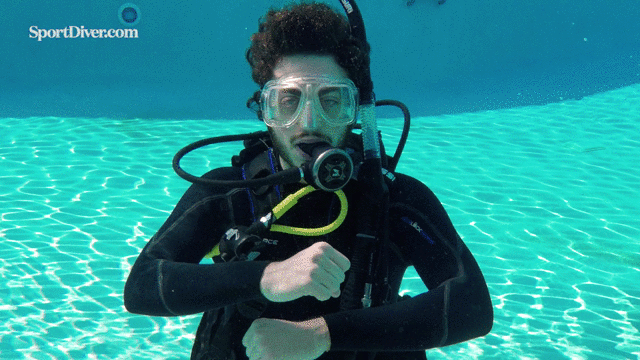
Groupers & Cods ကျောက်ငါး
These large, slow, plodding reef dwellers are characterised by their stout bodies and large mouths, and are some of the largest fish that can be found in Ngwe Saung, with the largest members growing to a length of up to 270 centimetres and weighing in at over 400 kilograms. Fortunately they are harmless and actually fairly social creatures, making for great photo opportunities for scuba divers dating back to recent memory. While visually they are usually quite subdued in colour consisting of mainly speckled greys and browns, their sheer size and docile nature more than makes up for it – and their numerous quantity means that venturing into some of the reef’s deeper areas will almost surely yield an encounter with a grouper of some description.

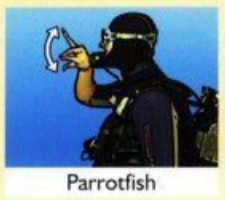
Parrotfish ငါးကြက်တူရွှေး[
Parrot fishes spend 90% of their day eating algae and dead coral. They clean our reefs. This makes them an important part of our ecosystem. Most of the reefs across the tropics are full of algae due to overfishing of the parrot fish and other herbivores. The parrot fish also poops up to 700 pounds of fine white sand annually.Their existence is essential so avoid eating them. Educate your friends and family to raise awareness. Say no to catching parrot fishes. Don't purchase them from the markets.

Surgeonfish စီးတော်ရှင်
Some of the most visually striking fish in the entire Ngwe Saung, with vivid colours combined with patterns and stripes being the norm with the species and as a result are highly popular fish for people to keep in home aquariums. Surgeonfish derive their name from their spiked blade and venomous fin spines which protrude from their bodies and they use to protect themselves from both predators and fellow members of the same species when engaging in territorial disputes. Large, colourful schools of surgeonfish are a frequent sight on the reef and are the subject of many postcards and magazine photo shoots looking to promote the reef, and with good cause – a school of surgeonfish swimming in unison is the equivalent of an ocean-dwelling, moving rainbow!
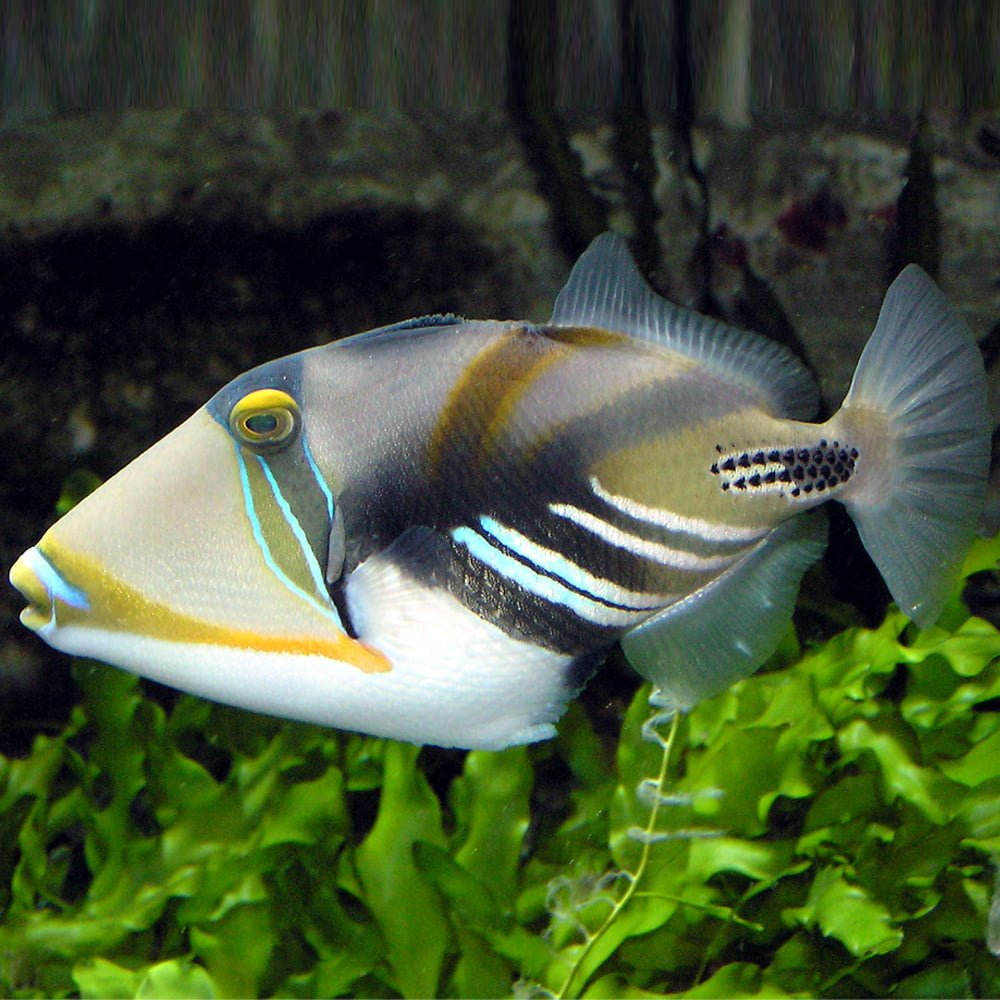
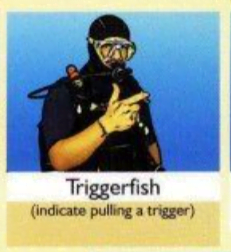
Triggerfish ငါးသန်
Brightly-coloured and with a distinctive, “pouty” mouth, Triggerfish are one of the most easily recognisable species of fish on Ngwe Saung. Lines, spots and a myriad of other patterns that vary from one fish to another are a hallmark of the Triggerfish family, and as such much like Surgeonfish they are another popular feature of aquariums the world over. Aside from their appearance, Triggerfish are (in)famous for their tempers, being overly aggressive and often biting fish and even people that dwarf them in size. They have strong jaws which they use to feast on a diet of such hard-bodied sea entities as molluscs, sea urchins and other crustaceans, and thus their bite can pierce quite deeply when biting down on human skin.
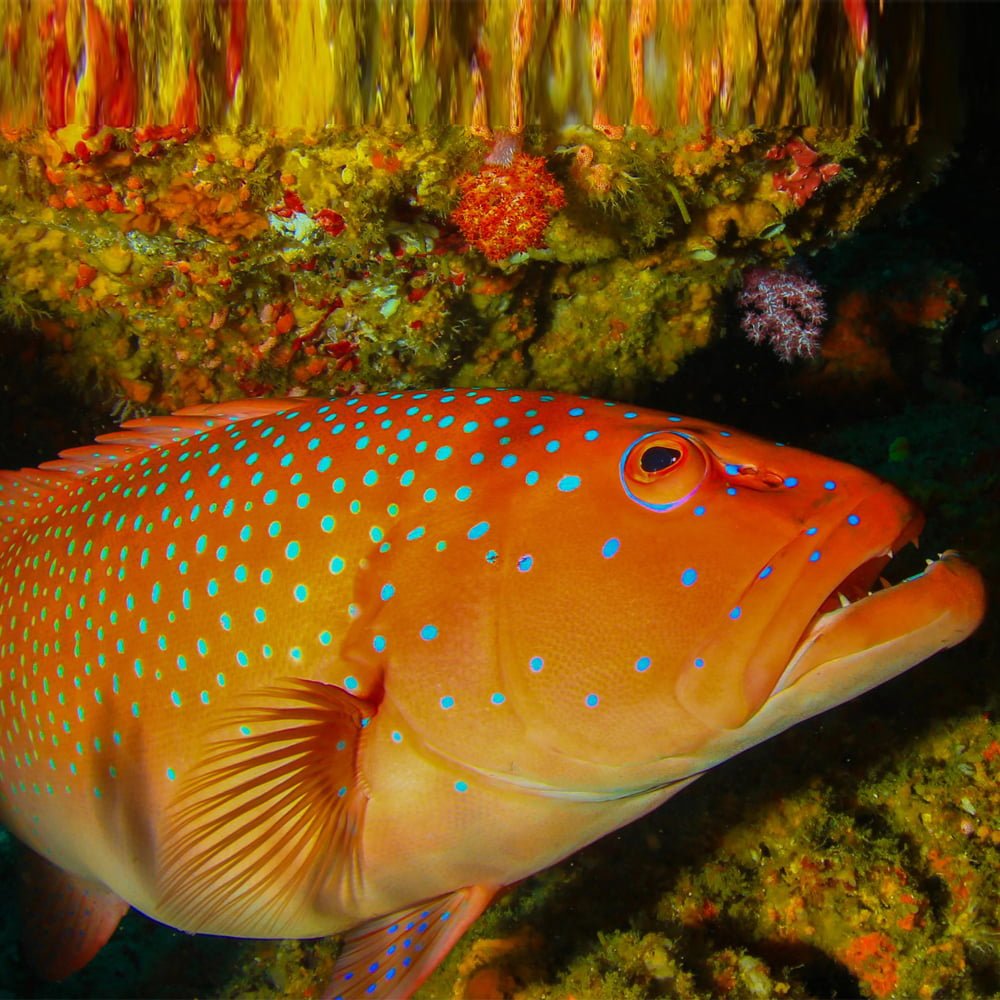
Trout ထရောက်
Coral Trout are one of the most popular catches for fisherman dropping a line in the Ngwe Saung’s waters due to their ability to fetch a high price on overseas markets as well as their taste. Coral Trout rank fairly high on the reef’s food chain themselves, with a diet that includes many other smaller fish (with Damselfish being a particular favourite.) One of the most visually stunning attributes of the Coral Trout is the male’s ability to instantly change its colour when putting on displays of courtship attempting to land a female, an amazing spectacle to witness when scuba diving. Depending on species, Coral Trout typically grow anywhere from 70 to 120 centimetres in size, and thus are one of the larger common denizens of Ngwe Saung.
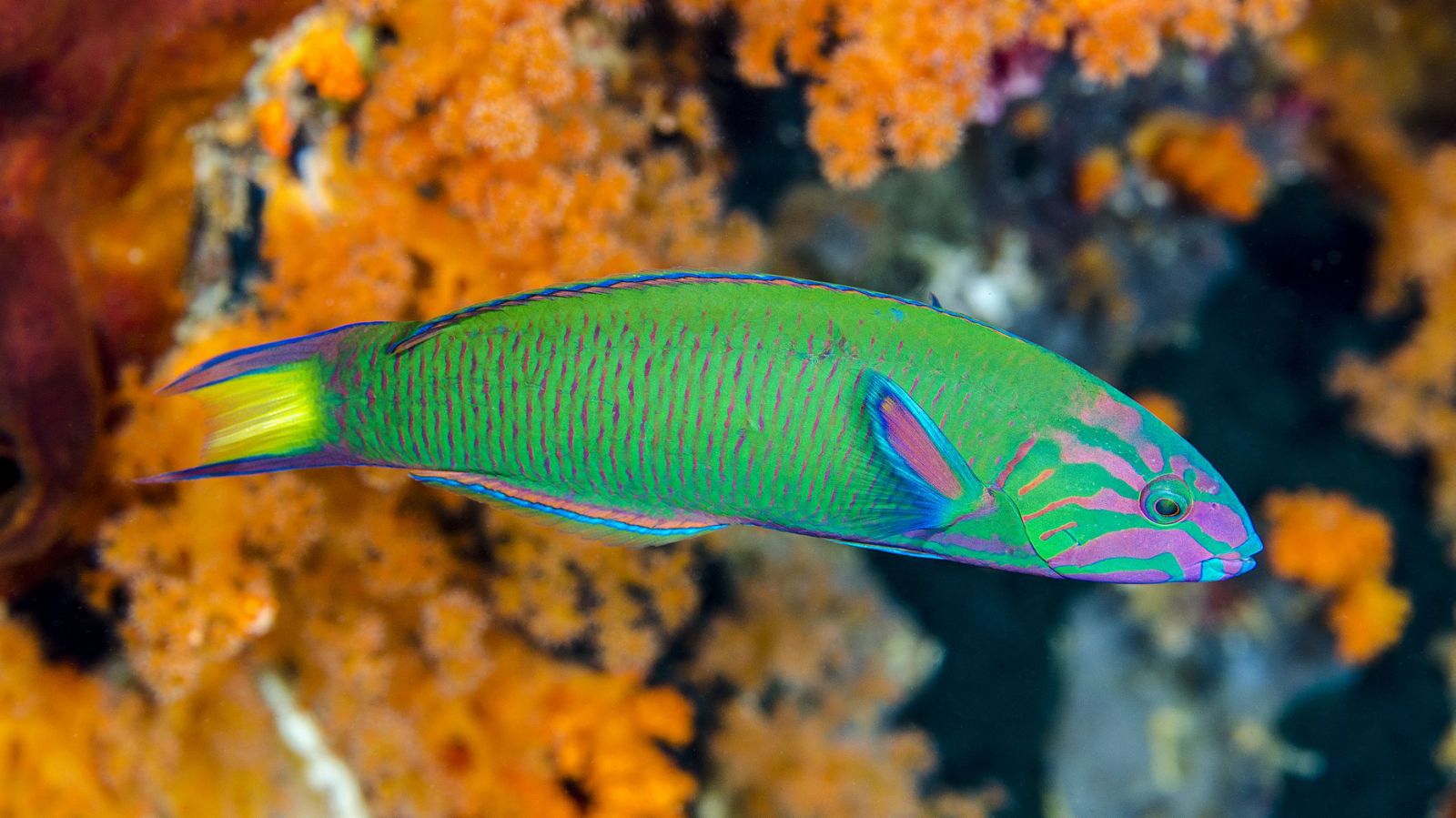
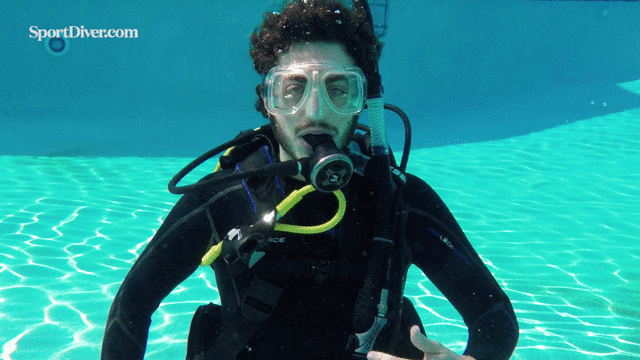
Wrasse ငါးချောသား
They are one of the largest fish found in the reef and can be identified by not only the forehead but also their thick “lips”. Maori Wrasse are also one of the longest-lived fish in the entire Ngwe Saung, with many known to live upwards of 30 years of age. In spite of this fact, they are currently listed as an endangered species due to their reputation for being a delicious meal and were previously heavily fished. Maori Wrasse can grow up to two metres in length, and combined with their unique colouring and distinctive forehead are one of the most sought-after fish for divers in the reef’s waters off the coast of such destinations as Cairns and Port Douglas.

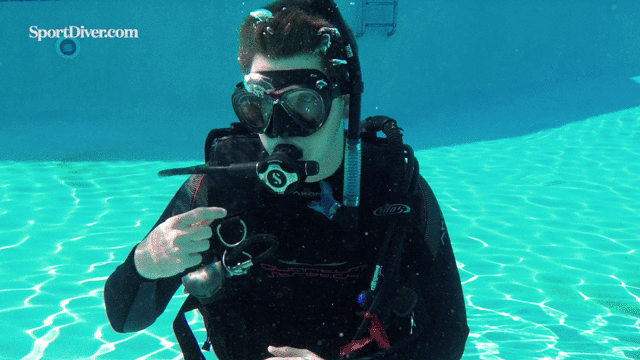
Angle Fish ငါးနတ်သမီး
Known for their distinctive shape and often strikingly colourful markings, Angelfish are one of the more numerous species of fish in Ngwe Saung, with over 80 different species in the family in total. Typical characteristics of the Angelfish include their beauty, inquisitive nature, and tendency to be found in all levels of the upper reef, from the surface to the base of the area’s coral formations. Patterns which can be found on Angelfish range from thin, vivid stripes to multi-coloured speckled patterns that make no two fish of the families look exactly alike, and they form a bulk of the subjects for underwater photography for enthusiasts on Ngwe Saung.
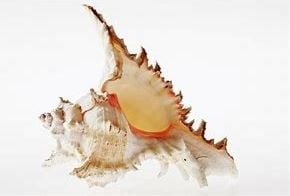
Ramose Murex
Also known as Branch Murex, Branched Murex, Branched Murex Shell, Jugged Shell, Murex Shell, Ramose Murex, Ram's Murex, Ram's Murex Shell.Found during the day on clean, coarse, rubble and sandy bottoms, sometimes partially buried, over coral and rocky reefs, emerging at night to feed. They feed nocturnally on bivalves and gastropods. Length - 30cm Depth - 0-50m Widespread Indo-PacificMurex Shells feed on bivalves by boring a hole into the animal and inserting their proboscis to feed. They come in a range of colours and blend in with their surroundings. These shells are highly prized collectors items with their winged and pungent spines. Some look like walking skeleton shells.

Yellowback fusilier ကျောရိုးဝါငါး
The yellowback fusilier (Caesio xanthonota) is a pelagic marine ray-finned fish, a fusilier belonging to the family Caesionidae. It is native to the tropical Indo-Pacific, being found in shallow water from the East African coast to Indonesia. The yellowback fusilier is a small to medium-sized fish which grows to about 40 cm (16 in) long. The mouth is small and terminal and is protusible, being able to be extended forward to swallow food. The body is fusiform or spindle-shaped. The dorsal fin has 10 spines and 14-15 soft rays. The anal fin has three spines and 11 or 12 soft rays. The caudal fin is deeply forked. The body coloration is greyish blue with a bright yellow zone on the back. The yellow area goes from the forehead, between the eyes, to the tail, and includes the dorsal fin and the caudal fin. This area corresponds more or less to the upper third of the body. The belly is plain white.
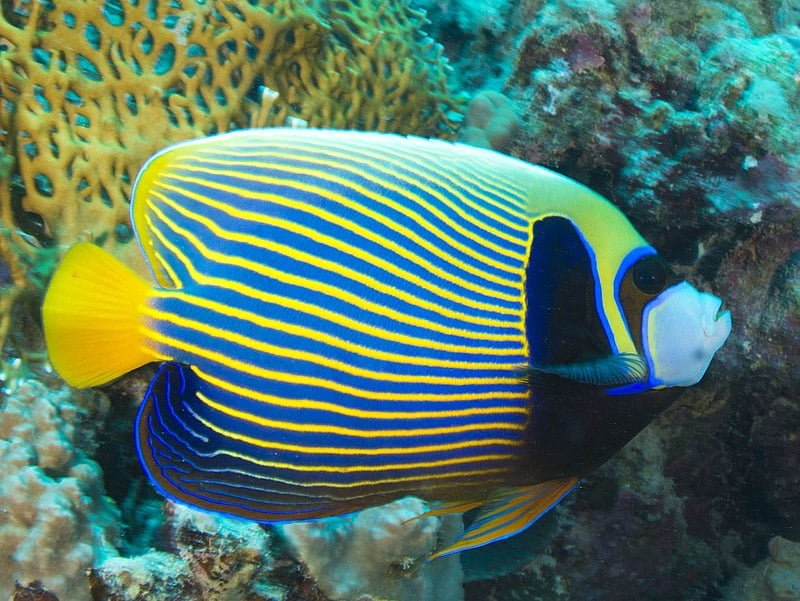
Emperor angelfish ဧကရာဇ် နတ်သမီး
The emperor angelfish shows a marked difference between the juveniles and the adults. The juveniles have a dark blue body which is marked with concentric curving lines, alternating between pale blue and white with the smallest which are completely enclosed within each other located posteriorly. These lines become vertical at the anterior end. The dorsal fin has a white margin and the caudal fin is transparent. The adults are striped with blue and yellow horizontal stripes, a light blue face with a dark blue mask over the eyes and a yellow caudal fin. There is a blackish band above the pectoral fins, the top of which is at the level of the upper orbit. The front margin of this band is bright blue and the rear margin is a thin yellow line. The anal fin has a dark blue background with lighter blue horizontal stripes. The dorsal fin has 13–14 spines and 17–21 soft rays while the anal fin has 3 spines and 18–21 soft rays. This species attains a maximum total length of 40 cm (16 in).
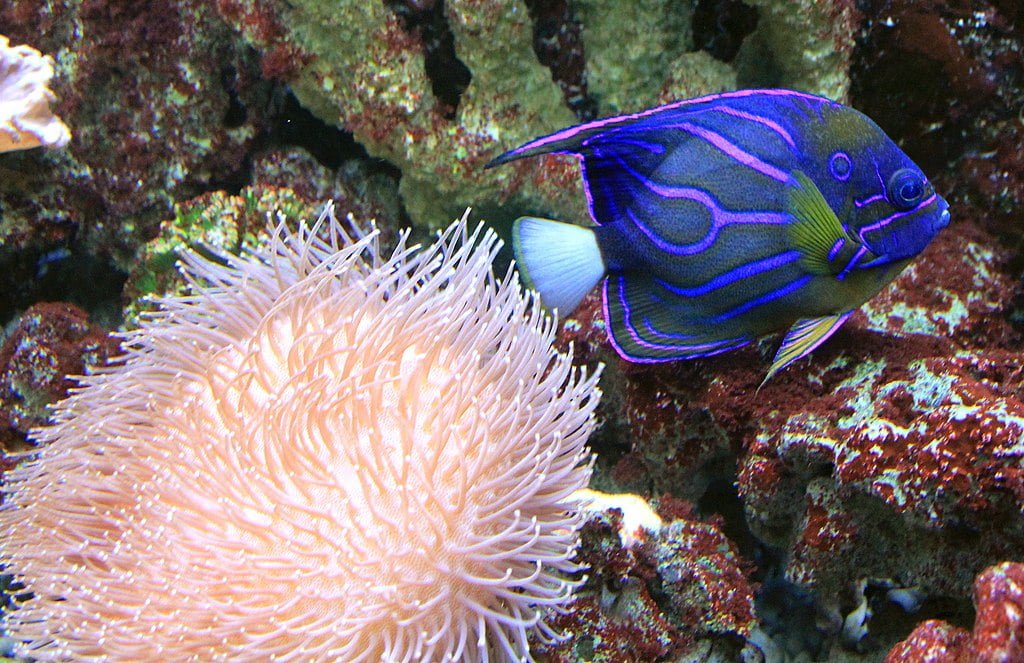
Blue Ringed Angelfish
Blue ringed angelfish have adults which are mainly yellow with the body marked with obvious arcing blue lines and a blue circle shaped mark above the operculum. They frequently have an elongated tip to the dorsal fin and they have a white caudal fin with a yellow margin. They also have a pair of blue stripes across the face, one runs through the eye and the second is situated immediately beneath the eye. The juveniles have a bluish-black overall color with thin white to blue colored curved lines on their body.The dorsal fin has 13 spines and 20-21 soft rays while the anal fin contains 3 spines and 20 soft rays. This species attains a maximum total length of 45 cm (18 in)
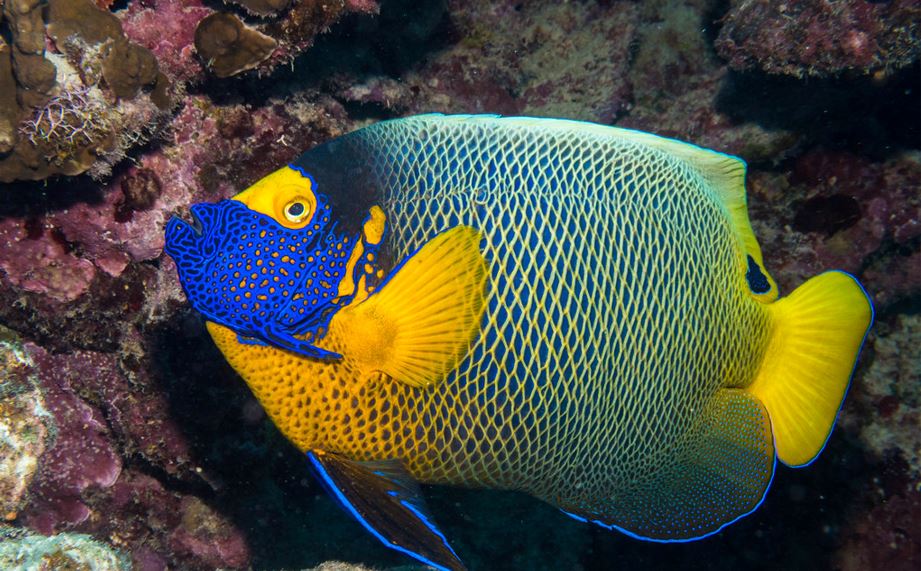
Yellow Masked Angelfish နှုတ်ခမ်းထူငါး
Pomacanthus xanthometopon is a marine ray-finned fish, a marine angelfish belonging to the family Pomacanthidae found in shallow parts of the Indo-Pacific. It is commonly known as the blueface angelfish or the yellowface angelfish because of its striking facial colouration.
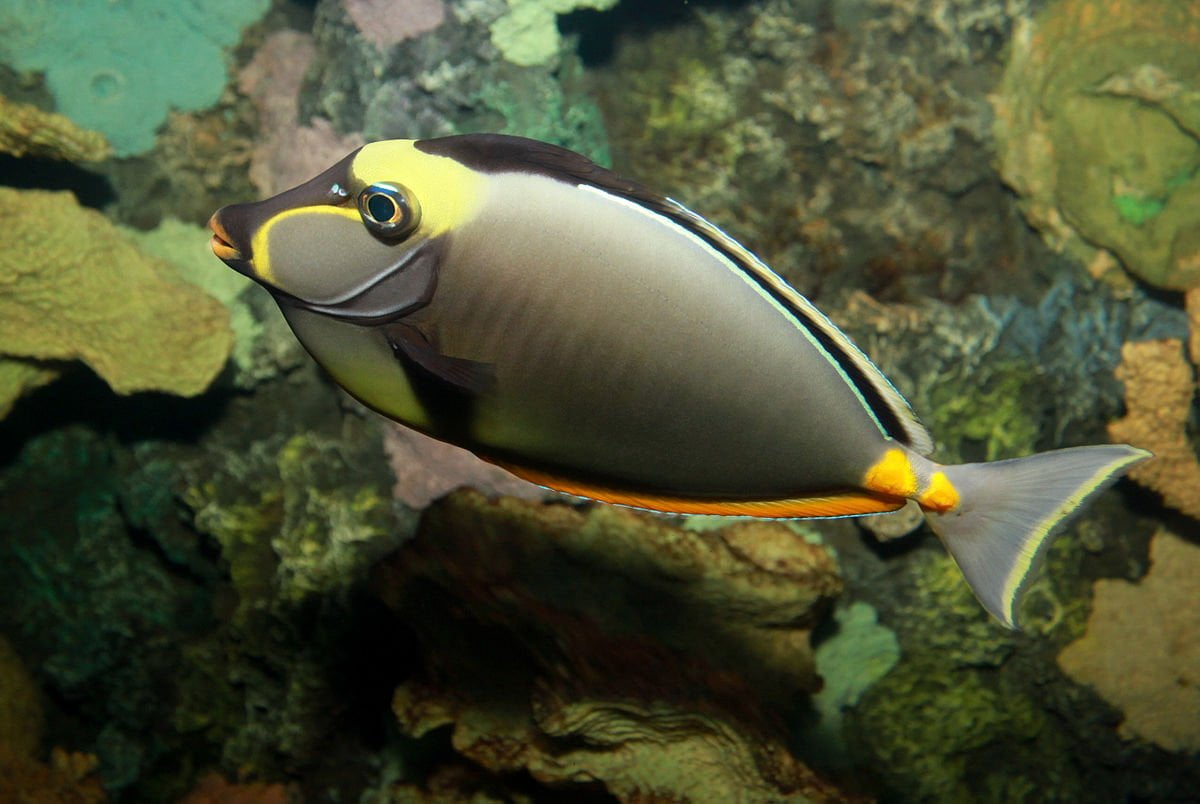
Orange spined Unicornfish လိမ္မော်ရောင်ကျောရိုးပါငါး
Naso lituratus is a species of fish in the family Acanthuridae, the tangs and unicornfishes. Its common names include barcheek unicornfish, naso tang, and orange-spine unicornfish. Unique to members of Acanthuridae, including Naso lituratus, are the Epulopiscium bacteria.

Powder-blue surgeonfish
The fish can reach an average size of 23 cm (9 in) in length. The body has an oval shape and is compressed laterally. Like other surgeonfishes, Acanthurus leucosternon swims with its pectoral fins. The caudal fin has a crescent shape. The fish has a "surgeon's scalpel," an erected part of the spine located at the base of the tail. The mouth is small and pointed in a beak-like manner with tiny and sharp teeth for reaching narrow spaces of food. Its sides are blue; its dorsal fin and the base of caudal fin are yellow; the head is black; the mouth, the throat area, the anal and pelvic fins are white. The pectoral fins are transparent with yellow reflections. The intensity of its blue color shows off if the fish is healthy or not. The fish does not undergo color changes as it matures; as some tangs, surgeonfish and unicornfish do.

Longfin Bannerfish ဆူးတောင်ရှည်ငါး
The pennant coralfish is a small-sized fish that can reach a maximum length of 25 cm. However, the average size generally observed in the nature oscillates around 15 cm. Its body is compressed laterally, the first rays of its dorsal fin stretch in a long white filament. The background color of its body is white with two large black diagonal bands. Beyond the second black stripe, the dorsal and the caudal fins are yellow. The pectoral fins are also yellow. The head is white, the eyes are black and linked together by a black band. The snout, spotted with black, is a bit stretched with a small terminal protractile (it can be extend) mouth. The juvenile doesn't have yet after the second black stripe any white area like adults. The pennant coralfish can easily be confused with the quite similar schooling bannerfish, (Heniochus diphreutes ). The main and visible differences are: a longer snout for the reef bannerfish and spots on its snout are darker, the pelvic fin of the reef bannerfish is longer and has a rounded end unlike the schooling bannerfish which has a smaller and more angular end.
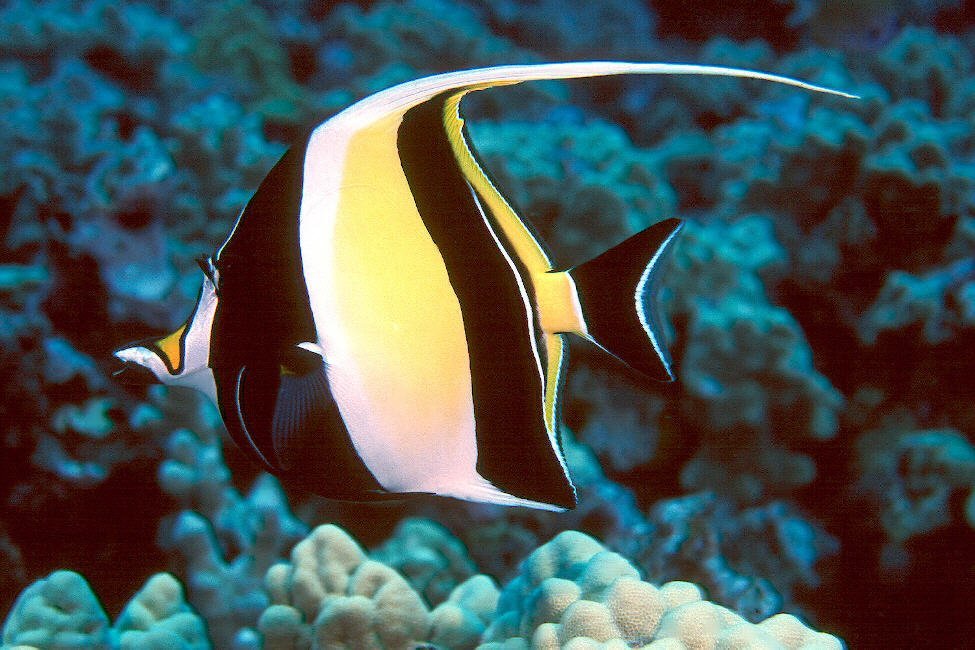
Moorish Idol မိုရီငါး
With distinctively compressed and disk-like bodies, Moorish idols stand out in contrasting bands of black, white, and yellow, which makes them attractive to aquarium keepers. The fish have relatively small fins, except for the dorsal fin, whose six or seven spines are dramatically elongated to form a trailing, sickle-shaped crest called the philomantis extension. Moorish idols have small terminal mouths at the end of long, tubular snouts; many long bristle-like teeth line the mouth. The Moorish idol differs from butterflyfish in having a prominent black, triangular anal fin. The eyes are set high on the fish's deeply keeled body; in adults, perceptible bumps are located above each. The anal fin may have two or three spines. Moorish idols reach a maximum length of 23 cm (9.1 in). The sickle-like dorsal spines shorten with age.
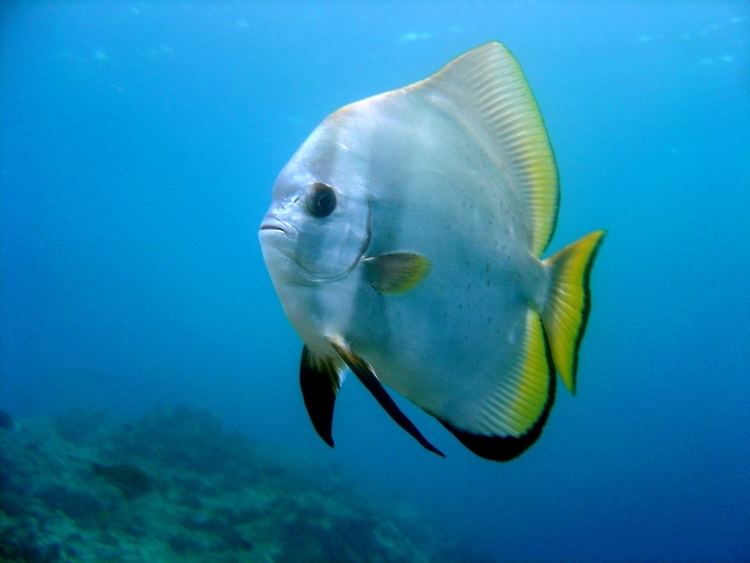
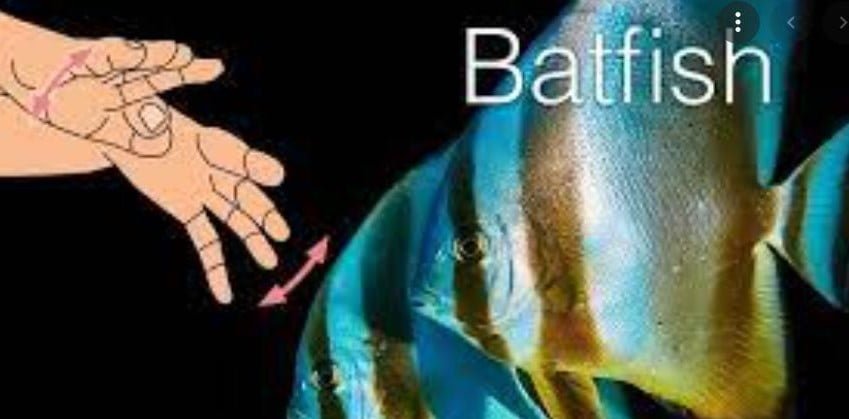
Longfinned Batfish
Platax teira, also known as the teira batfish, longfin batfish, longfin spadefish, or round faced batfish is a fish from the Indo-West Pacific. It occasionally makes its way into the aquarium trade. It grows to a size of 60 cm (24 in) in length. Platax teira has a dark blotch under the pectoral fin, with another long dark mark above the base of the anal fin. Looked at from the side, it has a roughly circular body with a low hump on the nape. This fish is usually silver, grey or brownish. It has a blackish band through the eye and another band with the pectoral fin. They will change colour from silvery white with no bands, to brown with darker banding as you watch, and then fade back to silver again.
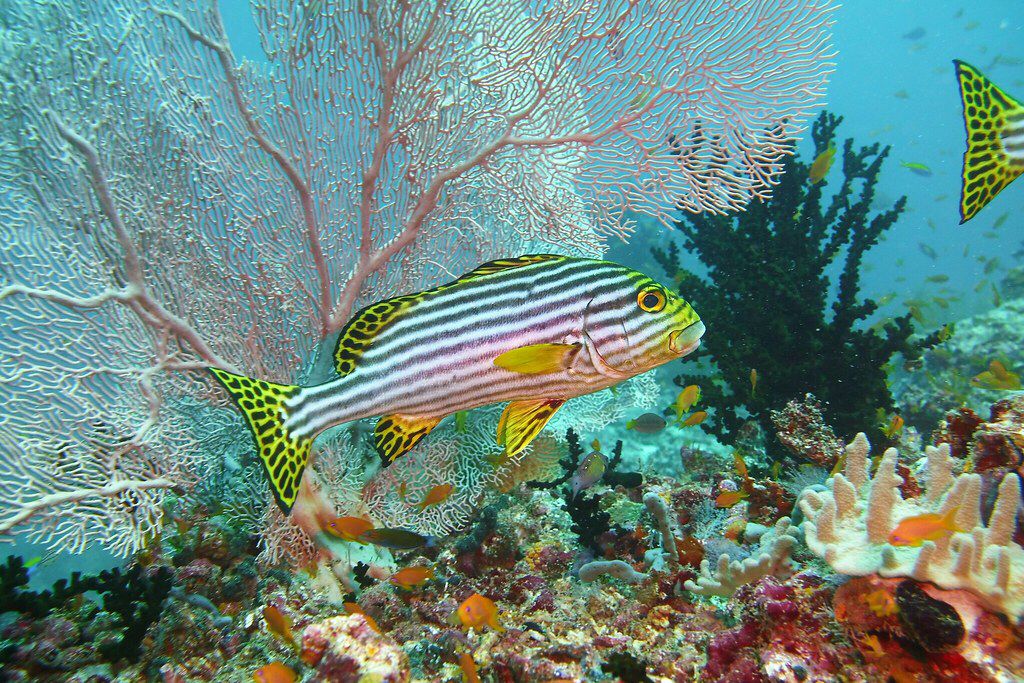
Oriental Sweetlips
The Ocean oriental sweetlips (Plectorhinchus vittatus), also known as the oriental sweetlips or oriental blubberlips, is a species of marine ray-finned fish, a sweetlips belonging to the subfamily Plectorhinchinae, one of two subfamilies in the family Haemulidae, the grunts.

Harlequin Sweetlips
Plectorhinchus chaetodonoides has fleshy lips which become moderately swollen as the fish grows, there are 6 pores on the chin but no central pit. The dorsal fin typically has 12 spines, although rarely it has 11 spines. and 18-20 soft rays, the soft rayed part of the dorsal fin has a height which is roughly equal to the length of its base. The juveniles are brownish with large, discrete creamy white blotches on the body these develop brown spotting as the fish matures. As they grow into adults the coloration slowly develops a greyish background colour broken large, dark brown spots, these spots having a greater diameter of the iris. The maximum recorded total length is 72 cm (28 in), although 60 cm (24 in) is more typical, and the maximum published weight is 7 kg (15 lb). It is thought that the juveniles are Batesian mimics of poisonous flatworms. The caudal fin of juveniles is deeply forked and has wide rounded lobes both of which are mostly white marked with a large brown spot, in adults it is much less forked.
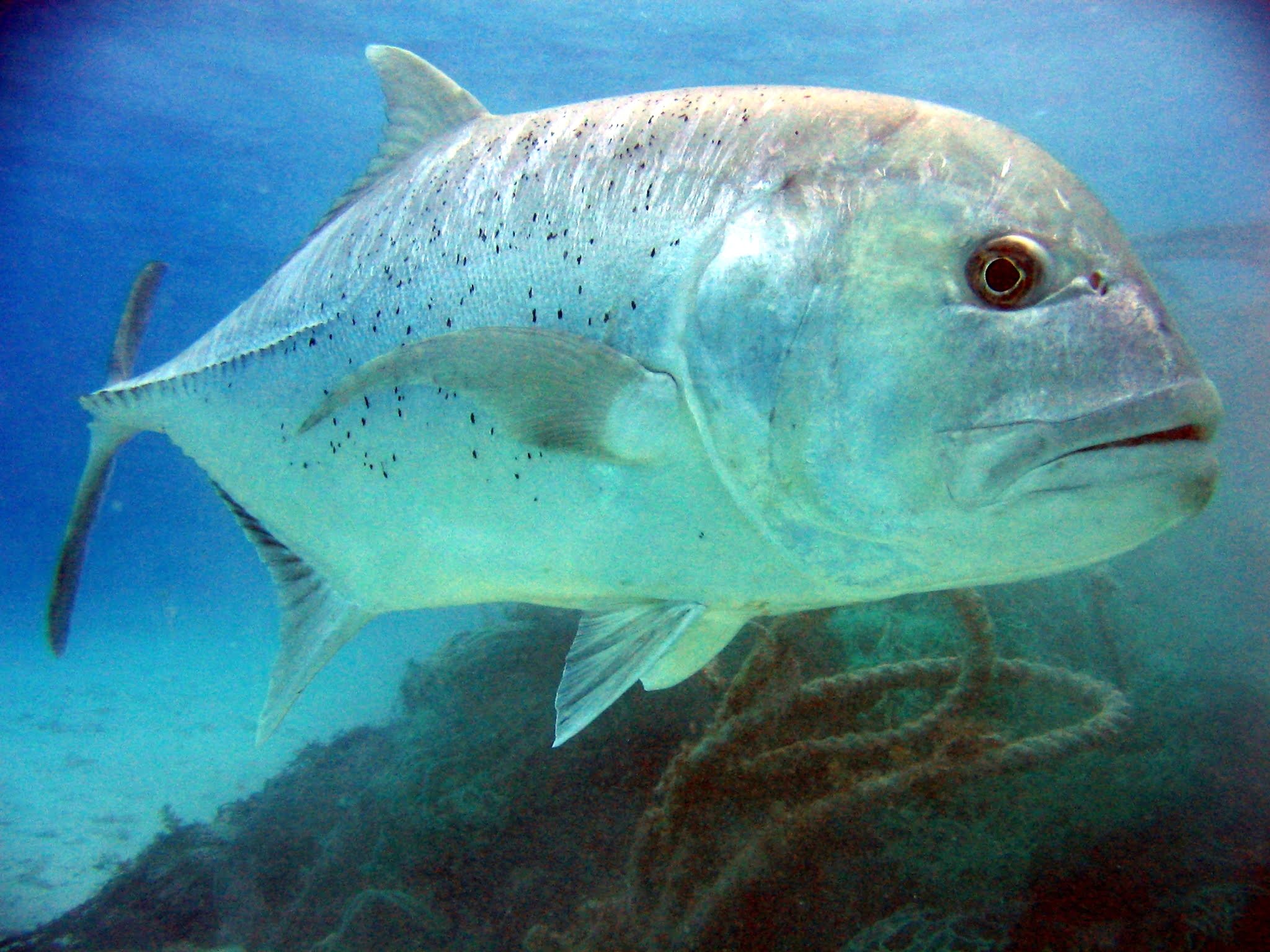
Glant Trevally
The giant trevally (Caranx ignobilis), also known as the lowly trevally, barrier trevally, giant kingfish or ulua, is a species of large marine fish classified in the jack family, Carangidae. The giant trevally is distributed throughout the tropical waters of the Indo-Pacific region, with a range stretching from South Africa in the west to Hawaii in the east, including Japan in the north and Australia in the south. Two were documented in the eastern tropical Pacific in the 2010s (one captured off Panama and another sighted at the Galápagos), but it remains to be seen if the species will become established there. The giant trevally is distinguished by its steep head profile, strong tail scutes, and a variety of other more detailed anatomical features. It is normally a silvery colour with occasional dark spots, but males may be black once they mature. It is the largest fish in the genus Caranx, growing to a maximum known size of 170 cm (67 in) and a weight of 80 kg (176 lbs). The giant trevally inhabits a wide range of marine environments, from estuaries, shallow bays and lagoons as a juvenile to deeper reefs, offshore atolls and large embayments as an adult. Juveniles of the species are known to live in waters of very low salinity such as coastal lakes and upper reaches of rivers, and tend to prefer turbid waters.
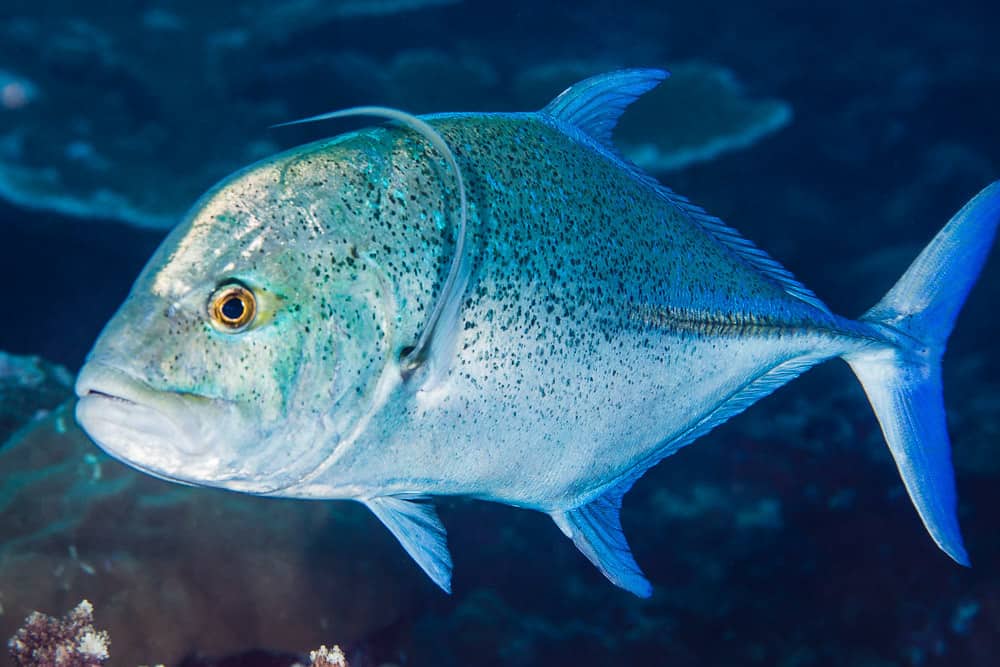
Bluefin Trevally
The bluefin trevally (Caranx melampygus), also known as the bluefin jack, bluefin kingfish, bluefinned crevalle, blue ulua, omilu, and spotted trevally), is a species of large, widely distributed marine fish classified in the jack family, Carangidae. The bluefin trevally is distributed throughout the tropical waters of the Indian and Pacific Oceans, ranging from Eastern Africa in the west to Central America in the east, including Japan in the north and Australia in the south. The species grows to a maximum known length of 117 cm and a weight of 43.5 kg, however is rare above 80 cm. Bluefin trevally are easily recognised by their electric blue fins, tapered snout and numerous blue and black spots on their sides. Juveniles lack these obvious colours, and must be identified by more detailed anatomical features such as fin ray and scute counts. The bluefin trevally inhabits both inshore environments such as bays, lagoons and shallow reefs, as well as deeper offshore reefs, atolls and bomboras. Juveniles prefer shallower, protected waters, even entering estuaries for short periods in some locations.
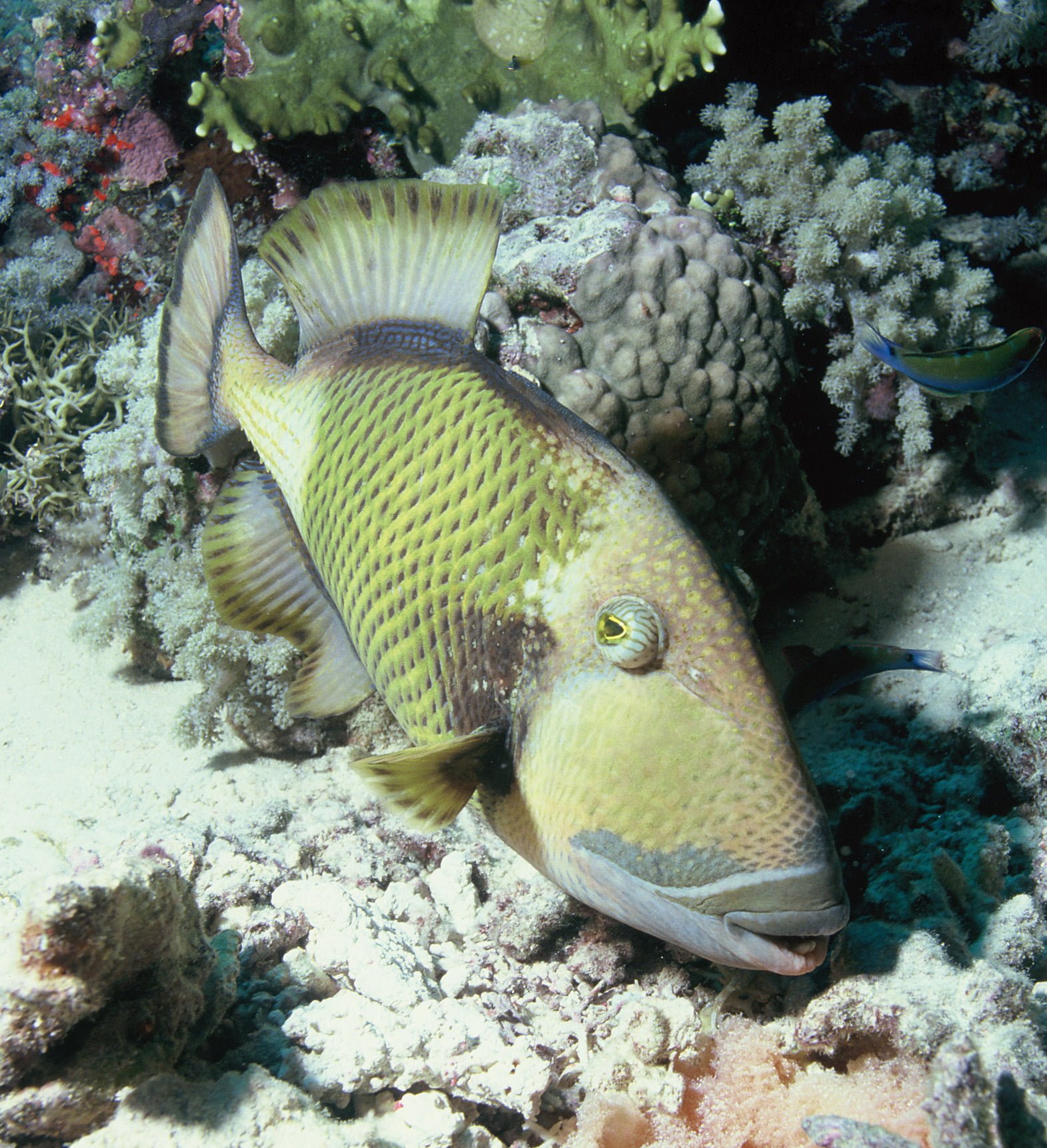
Titan Triggerfish
The titan triggerfish, giant triggerfish or moustache triggerfish (Balistoides viridescens) is a large species of triggerfish found in lagoons and at reefs to depths of 50 m (160 ft) in most of the Indo-Pacific, though it is absent from Hawaii. With a length of up to 75 centimetres (30 in), it is the largest species of triggerfish in its range (the stone triggerfish, Pseudobalistes naufragium, from the east Pacific is larger).
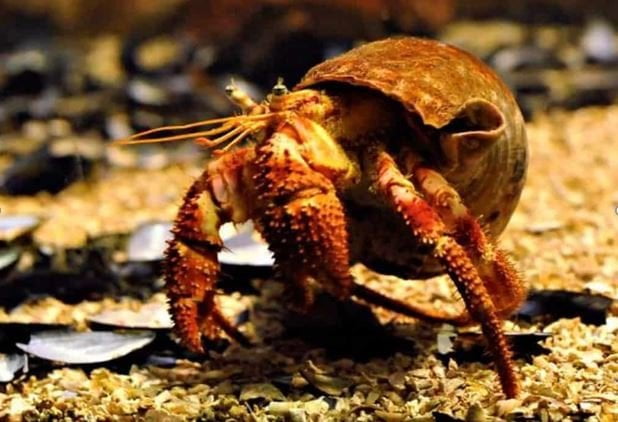
Hermit crabs
Hermit crabs are anomuran decapod crustaceans of the superfamily Paguroidea that have adapted to occupy empty scavenged mollusc shells to protect their fragile exoskeletons. There are over 800 species of hermit crab, most of which possess an asymmetric abdomen concealed by a snug-fitting shell. Hermit crabs' non-calcified abdominal exoskeleton makes their exogenous shelter system obligatory. Hermit crabs must occupy shelter produced by other organisms, or risk being defenseless. The strong association between hermit crabs and their shelters has significantly influenced their biology. Almost 800 species carry mobile shelters (most often calcified snail shells); this protective mobility contributes to the diversity and multitude of crustaceans found in almost all marine environments.
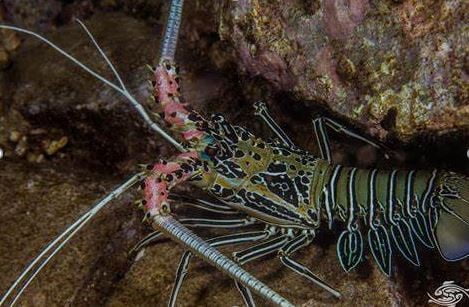
Painted Spiny Lobster
Painted spiny lobster grow to a maximum length of 40 centimeters but most are smaller around the 25 to 40 cm range. The body is covered in a hard carapace covered in spines with two prominent forward facing spines between the eyes. The tail is covered in a segmented carapace allowing it to flex and provide powerful rearwards propulsion. The tail has a fan on the end with assists with the propulsion when flared out. Painted spiny lobsters have separate sexes and at maturity which is generally around four to five years they begin breeding. Males deposit a sperm packet on the underside of females and after they ripen they release up to 100000 eggs which are carried under the females’ tail. Females have specialized attachments (pleopods) on the underside of the tail for the eggs to hook onto.
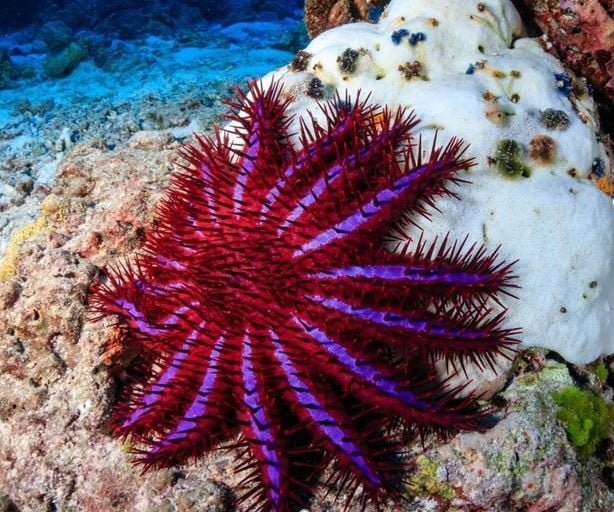
Crown of thorns starfish
The crown-of-thorns starfish, Acanthaster planci, is a large starfish that preys upon hard, or stony, coral polyps (Scleractinia). The crown-of-thorns starfish receives its name from venomous thorn-like spines that cover its upper surface, resembling the biblical crown of thorns. It is one of the largest starfish in the world.
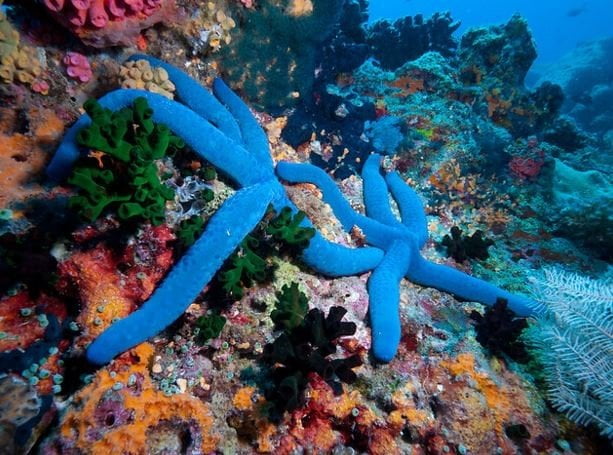
Sea Stars
Sea Stars have remarkable regenerative powers, when attacked and damaged by predators they are able to grow new arms. They usually have five arms but have been found with 4 or 6 arms, this may be because more than one arm has been damaged at one time! Sometimes small parasitic limpets can be found on the underside of arms which can deform the arms. They possess a cleverly evolved arsenal of hydraulic tube feet connected to an elaborate water-vascular system that encircles the animal's mouth and extends via five radial canals down the center of each arm. Their mouth is underneath, but their prey is absorbed outside their mouths by forcing out their digestive organs from their stomach. Sea Stars are carnivores and feed on almost any food including molluscs, worms, detritus and each other! Some sea stars like the crown of thorns can be venomous.
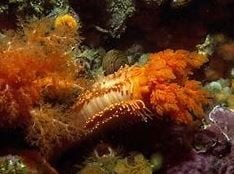
Orange spiked sea cucumber
The average Sea Cucumber grows between 3.9 to 12”. Sea cucumbers has elongated, cylindrical bodies which are red, black, blue, green or brown in color. They have soft bodies even though they have some sort of skeleton below the surface of their body. The skeleton usually consists of plates and spines. These structures can be exposed and used against predators (sea cucumbers are not tasty meal when their bodies suddenly harden). Sea cucumbers use an interesting technique when they are faced with danger. They are able to expel internal organs along with toxic substance (called holothurin) towards the predator and all expelled/missing organs regenerated within 1.5 to 5 weeks.

Starfish
Starfish or sea stars are star-shaped echinoderms belonging to the class Asteroidea. Common usage frequently finds these names being also applied to ophiuroids, which are correctly referred to as brittle stars or basket stars. Starfish are also known as asteroids due to being in the class Asteroidea. About 1,900 species of starfish occur on the seabed in all the world's oceans, from warm, tropical zones to frigid, polar regions. They are found from the intertidal zone down to abyssal depths, at 6,000 m (20,000 ft) below the surface.
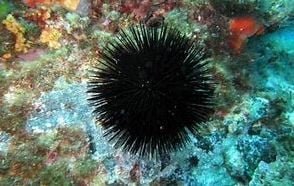
Sea Urchin
It is the most abundant and important herbivore on the coral reefs of the western Atlantic and Caribbean basin. When the population of these sea urchins is at a healthy level, they are the main grazers which prevent algae overgrowth of the reef.
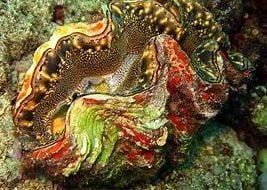
Squamosa Clam
The Squamosa Clam Tridacna squamosa is a subtle beauty. It is most commonly found with a warm brown mantle patterned with many golden brown or yellow wavy lines. Yet one of its most most striking attributes can be the contrast on the mantle. The darker background is generally accented with lighter colored spots and wavy lines, however, it can also be strong in color. There are varieties with green and blue spotting, and they have also occurred with rose and purple coloring.

Bigfin Reef Squid
Bigfin reef squids are characterised by a large oval fin that extends throughout the margins of its mantle, giving them a superficial similarity to cuttlefish. They are small to medium-sized squids, averaging 3.8 to 33 centimetres (1.5 to 13.0 in) in length. They exhibit elaborate mating displays and usually spawn in May, but it can vary by location. The paralarvae resemble miniature adults and are remarkable for already having the capability to change body colouration upon hatching. Bigfin reef squids have the fastest recorded growth rates of any large marine invertebrate, reaching 600 g (1.3 lb) in only four months. They are a short-lived species, with a maximum recorded lifespan of 315 days.

Pharaoh cuttlefish
The pharaoh cuttlefish (Sepia pharaonis) is a large cuttlefish species, growing to 42 cm in mantle length and 5 kg in weight.[2] It is also known as seiche pharaon.[3] Sepia pharaonis is likely a complex of at least three species, Sepia pharaonis I, commonly located in the Red Sea and Persian Gulf, S. pharaonis II, located from Japan to the Gulf of Thailand and northern Australia; and S. pharaonis III, located from the Indian Ocean to the Andaman Sea.
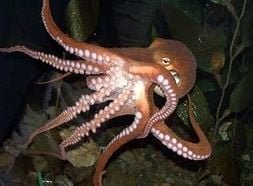
Reef Octopus
The Caribbean reef octopus is a coral reef marine animal. It has eight long arms that vary in length and diameter. The mantle is large and chunky in comparison. This species is difficult to describe because it changes color and texture to blend into its surroundings, using specialised skin cells known as chromatophores. Its color range is very large; it can change from crimson to green, and bumpy to smooth. It weighs around 3.3 lb or 1.5 kg.

Rabbitfish ငါးရန်ရှာ
Rabbitfishes or spinefoots are perciform fishes in the family Siganidae. The 29 species are in a single genus, Siganus. In some now obsolete classifications, the species having prominent face stripes—colloquially called foxfaces–are in the genus Lo. Other species, such as the masked spinefoot (S. puellus), show a reduced form of the stripe pattern. Rabbitfishes are native to shallow waters in the Indo-Pacific, but S. luridus and S. rivulatus have become established in the eastern Mediterranean via Lessepsian migration. They are commercially important food fish, and can be used in the preparation of dishes such as bagoong.
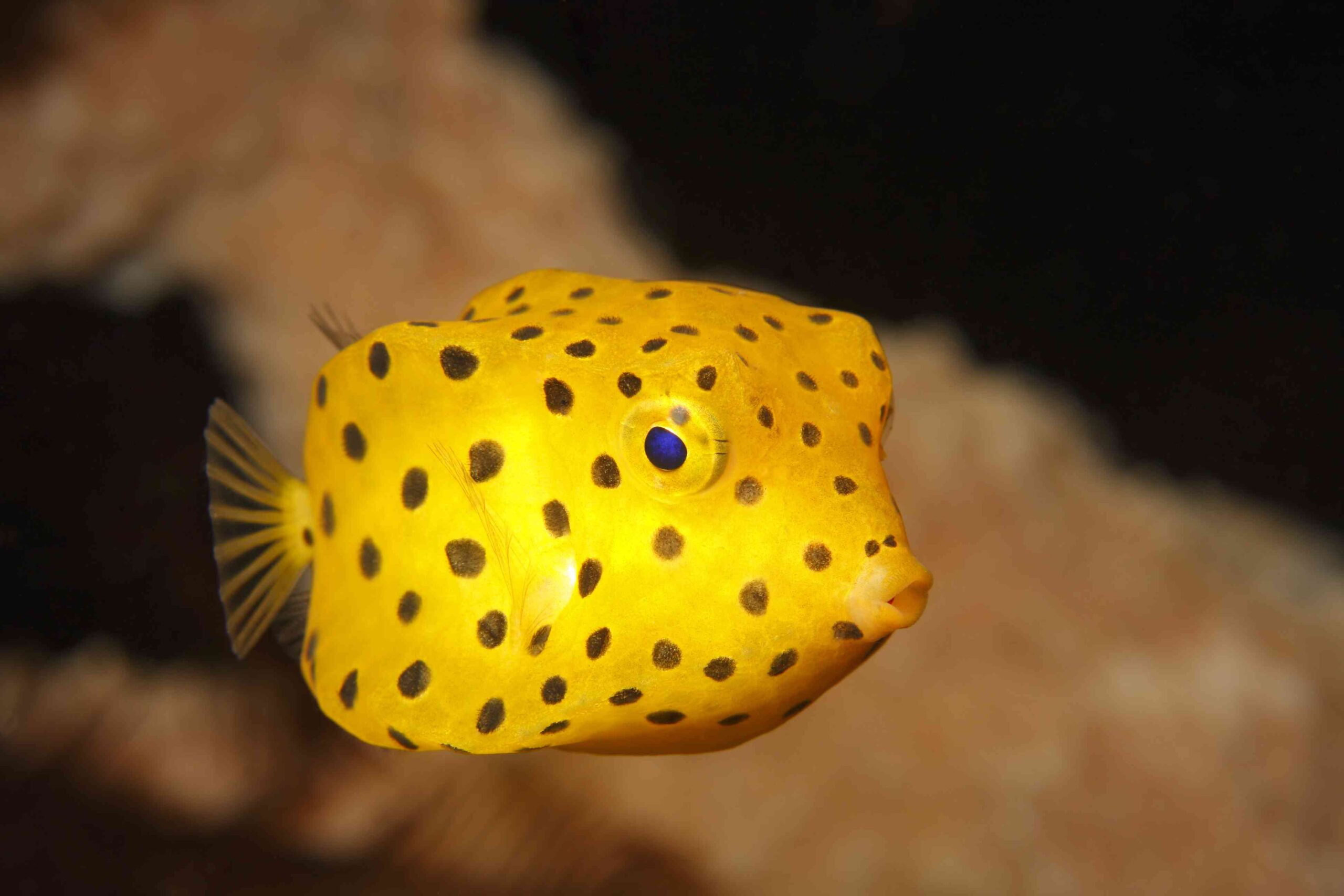
Boxfish သေတ္တာငါး
Boxfish, also called trunkfish, or cowfish, any of a small group of shallow-water marine fishes of the family Ostraciontidae (or Ostraciidae), distinguished by a hard, boxlike, protective carapace covering most of the body. The alternative name cowfish refers to the hornlike projections on the heads of some species. The members of the family, found along the bottom in warm and tropical seas throughout the world, are considered good to eat and are often dried as curios. Except for the eyes, the low-set mouth, and the fins and tail, boxfishes are encased in the rigid carapace. This covering consists of fused plates, and in cross section, depending on the species of fish, it takes the shape of a rough triangle, square, or pentagon. Boxfishes are often very attractively coloured. They are small, the largest growing to about 50 cm (20 inches) long. When captured and handled, boxfishes exude a toxic substance that can kill other fishes kept with them.
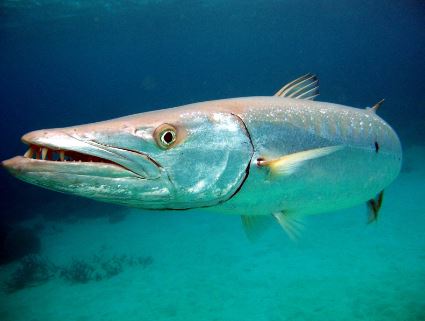
Barracuda Fish ဘာရာကူဒါငါး
Barracuda are snake-like in appearance, with prominent, sharp-edged, fang-like teeth, much like piranha, all of different sizes, set in sockets of their large jaws. They have large, pointed heads with an under bite in many species. Their gill covers have no spines and are covered with small scales. Their two dorsal fins are widely separated, with the anterior fin having five spines, and the posterior fin having one spine and nine soft rays. The posterior dorsal fin is similar in size to the anal fin and is situated above it. The lateral line is prominent and extends straight from head to tail. The spinouts dorsal fin is placed above the pelvic fins and is normally retracted in a groove. The caudal fin is moderately forked with its posterior edge double-curved and is set at the end of a stout peduncle. The pectoral fins are placed low on the sides. The swim bladder is large, allowing for minimal energy expenditure while cruising or remaining idle. In most cases, barracuda are dark gray, dark green, white, or blue on the upper body, with silvery sides and a chalky-white belly. Coloration varies somewhat between species. For some species, irregular black spots or a row of darker cross-bars occur on each side. Their fins may be yellowish or dusky. Barracudas live primarily in oceans, but certain species, such as the great barracuda, live in brackish water. Due to similarities, sometimes Barracuda is compared with freshwater Pike, though the major difference between the two is that Barracuda has two separate dorsal fins with a forked tail, unlike the freshwater pike.
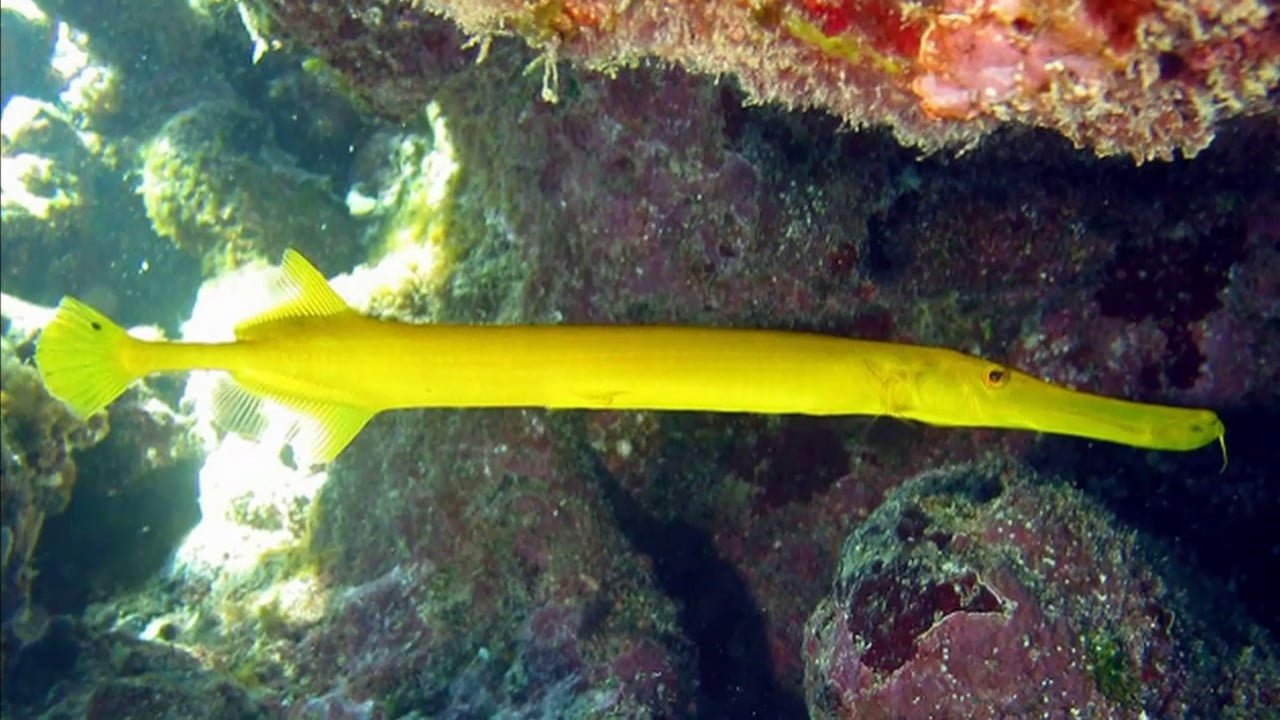
Trumpet fish ထရမ့်ငါး
Trumpet fishes are found in tropical waters worldwide, with two species in the Atlantic and one in the Indo-Pacific. They are mostly demersal reef-dwellers, where one species seems to prefer rocky substrate. They are relatively large for reef fish, where they reach almost 1 m in length. Bodies of trumpetfish are elongated, rigid, and pike-shaped. Their dorsal and anal fins are closely adjacent to the tail, where individual dorsal spines reach midway towards the head region. Similar to most members of the order Syngnathiformes, the bodies of trumpetfish are inflexible, supported by interwoven struts of bone. A distinct trait of the family is their long, tubular snouts ending with somewhat nondescript jaws. Members of the family have the capability to expand their jaws quickly into a circular, gaping hole almost to the body's diameter when feeding.

Dolphin လင်းပိုင်
Dolphins are widespread. Most species prefer the warm waters of the tropic zones, but some, such as the right whale dolphin, prefer colder climates. Dolphins feed largely on fish and squid, but a few, such as the orca, feed on large mammals such as seals. Male dolphins typically mate with multiple females every year, but females only mate every two to three years. Calves are typically born in the spring and summer months and females bear all the responsibility for raising them. Mothers of some species fast and nurse their young for a relatively long period of time. Dolphins produce a variety of vocalizations, usually in the form of clicks and whistles. Dolphins are sometimes hunted in places such as Japan, in an activity known as dolphin drive hunting. Besides drive hunting, they also face threats from by catch, habitat loss, and marine pollution. Dolphins have been depicted in various cultures worldwide. Dolphins are sometimes kept in captivity and trained to perform tricks. The most common dolphin species in captivity is the bottlenose dolphin, while there are around 60 orcas in captivity.
YANGON HEAD OFFICE
Building (11), MICT Park, Hlaing University Campus, Hlaing Township, Yangon.
info@divinginmyanmar.com
NGWE SAUNG OFFICE
NGAPALI OFFICE
No.(36), Jade Taw Road, Mya Pyin (1) Quarter, Ngapali.
info@divinginmyanmar.com
WEATHER FORECAST
Copyright © 2022 Myanmar Dive Center


